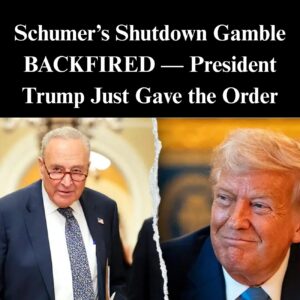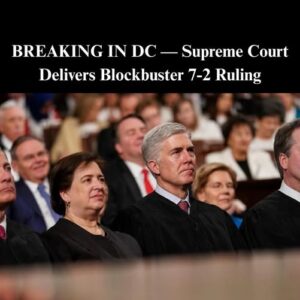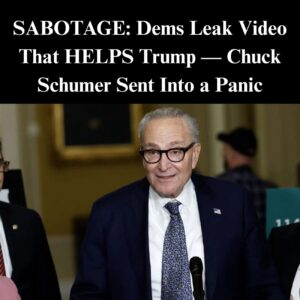This article may contain commentary which reflects the author’s opinion.
As midnight struck on Wednesday, the machinery of the federal government began its familiar descent into partial paralysis—a scenario that has become almost ritualistic in American politics, yet never loses its capacity to disrupt lives and shake public confidence. But this shutdown carries a particular intensity, driven by political calculations that extend far beyond budget numbers and into the realm of personal political survival and partisan positioning for battles yet to come.
The Senate chamber, typically a place where compromise at least remains theoretically possible, has instead become ground zero for a confrontation that both parties claim the other orchestrated. The failure of yet another funding vote—the third in as many attempts—suggests that the usual escape hatches that prevent shutdowns have been deliberately sealed, raising questions about whether this impasse represents genuine policy disagreement or political theater with real consequences for millions of Americans.
The Third Rejection: A Pattern Emerges
Wednesday’s Senate vote on the House-passed Clean Resolution produced results that were both predictable and revealing. The measure, requiring 60 votes to advance, failed 55-45—a margin that suggests the votes for passage exist in theory but remain blocked by partisan discipline and strategic calculation.
The terminology “Clean Resolution” itself has become politically charged, with Republicans arguing that their proposal simply continues current funding levels without controversial additions, while Democrats characterize the GOP approach as anything but clean. This semantic battle over what constitutes a “clean” funding bill reflects deeper disagreements about baseline assumptions and priorities.
The vote breakdown revealed some cracks in Democratic unity, with Sen. Catherine Cortez Masto of Nevada, a member of the Senate Democratic leadership team, joining Sen. John Fetterman of Pennsylvania and independent Sen. Angus King of Maine in voting for the Republican funding proposal. These defections, while insufficient to overcome the 60-vote threshold, signal that not all Democrats are comfortable with their leadership’s strategy.
Cortez Masto’s vote is particularly significant given her leadership position. Her willingness to break with Schumer on such a high-profile vote suggests either genuine policy disagreement or recognition that her Nevada constituents may not appreciate extended shutdown drama. The political courage required to defy leadership on such matters should not be underestimated.
Fetterman’s support for the funding measure continues his pattern of occasionally breaking with Democratic orthodoxy on issues where he believes his party has moved too far left. His willingness to buck leadership has made him both a target of progressive criticism and a potential model for Democrats in competitive states who cannot afford to be seen as reflexively partisan.
King’s vote reflects the independent senator’s historical tendency to seek practical solutions over partisan victories. As someone who technically sits outside the Democratic caucus while generally voting with them, King has more freedom to pursue what he views as sensible compromise without facing the same intra-party pressures as elected Democrats.
Chuck Schumer’s Dilemma: Leadership Under Siege
Senate Minority Leader Chuck Schumer finds himself in an increasingly uncomfortable position, facing criticism from directions that rarely converge. Republicans predictably blast him for blocking funding measures, but the emergence of significant criticism from Democratic circles and typically sympathetic media represents a more unusual and potentially more threatening development.
Schumer’s past opposition to government shutdowns is well-documented, making his current stance appear inconsistent to observers who remember his previous warnings about the consequences of funding lapses. This apparent reversal has provided Republicans with ammunition to paint him as a hypocrite willing to sacrifice principle for political advantage.
The political calculus behind Schumer’s position becomes clearer when viewed through the lens of intra-party dynamics. The Democratic Party’s left-wing faction was reportedly “apoplectic” at Schumer for providing votes in March to keep the government funded. That earlier decision to work with Republicans represented the kind of pragmatic compromise that has historically characterized Senate leadership but increasingly conflicts with progressive demands for uncompromising resistance.
By allowing the shutdown to proceed now, Schumer appears to be placating these left-wing critics who view any cooperation with the Trump administration as betrayal. This strategy of satisfying the base, however, comes with significant risks that extend beyond the immediate shutdown consequences.
The “Schumer Shutdown” Narrative: Branding Wars
Republicans have seized the opportunity to brand the current impasse as the “Schumer Shutdown,” a label that appears to be gaining traction in media coverage and public discourse. This branding battle matters enormously, as historical precedent suggests that whichever party gets tagged with responsibility for shutdowns tends to suffer politically.
The effectiveness of the “Schumer Shutdown” framing depends on several factors: the duration of the shutdown, its impact on visible government services, and the media’s willingness to adopt or challenge the Republican narrative. Early indications suggest that even some traditionally Democratic-leaning commentators are questioning Schumer’s strategy, giving the Republican framing more credibility than it might otherwise enjoy.
The irony of Schumer potentially being blamed for a shutdown after years of criticizing Republican-led shutdowns provides a narrative coherence that may prove difficult to overcome. The apparent hypocrisy of the position—opposing shutdowns when Republicans pursue them but accepting or even encouraging shutdowns when it serves Democratic political purposes—undercuts the moral high ground that Democrats typically claim on governance issues.
If the “Schumer Shutdown” label sticks in public consciousness, it could have long-term implications for Democratic messaging on government competence and responsible governance. The party that has historically positioned itself as the defender of government programs and services faces an uphill battle explaining why it blocked funding for those same programs and services.
The AOC Factor: Primary Politics and Leadership Vulnerability
Understanding Schumer’s apparent shift toward accepting shutdown risk requires examining the political threats he faces within his own party. Strong rumors that Representative Alexandria Ocasio-Cortez is considering a primary challenge against Schumer in 2028 have reportedly influenced his strategic calculations on the funding fight.
AOC represents the ascendant progressive wing of the Democratic Party, particularly in New York, where she has built a formidable political operation and national profile. A primary challenge from her would force Schumer to defend his left flank in ways that could compromise his effectiveness as Senate leader and potentially cost him his seat.
The far left’s anger about Schumer’s March decision to help keep the government funded created a political vulnerability that he apparently feels compelled to address. By allowing the shutdown to proceed now, Schumer signals to progressive critics that he hears their concerns and is willing to take harder lines against Republican priorities—even if doing so conflicts with his stated principles about government shutdowns.
This interpretation of Schumer’s motivations—that he is “choosing his political livelihood over what’s best for the country,” as Sen. Roger Marshall put it—raises troubling questions about leadership priorities and whether individual political survival can justify decisions that harm the national interest. If Senate leaders make strategic choices based primarily on internal party dynamics rather than broader governance concerns, it suggests a level of political dysfunction that transcends typical partisan disagreements.
The potential for a 2028 primary challenge shouldn’t ordinarily drive decisions in 2025, but the need to maintain progressive support and avoid months of damaging intra-party attacks may have convinced Schumer that accommodating the left now prevents larger problems later. This preemptive capitulation, however, sets a dangerous precedent about who really controls Democratic strategy in the Senate.
Republican Critique: Elections and Their Consequences
Senator Roger Marshall’s extended critique of Schumer’s position articulates the Republican perspective on the shutdown with unusual clarity and force. His argument that “elections have consequences” and that the left “lost the election” frames the funding fight as fundamentally about whether Democrats will accept the reality of their electoral defeat.
Marshall’s characterization that Republicans have merely asked Democrats to “continue funding at the levels that they chose” attempts to paint the GOP position as reasonable and the Democratic resistance as obstinate. By noting that Democrats want “one and a half trillion dollars more,” Marshall frames the dispute as being about excessive spending demands rather than legitimate policy differences.
The Kansas Republican’s diagnosis that “the left has taken over the Democrat Party” reflects a broader conservative narrative about Democratic politics that sees progressives as having captured party machinery and forced more moderate members into uncomfortable positions. Whether this characterization is accurate or represents partisan oversimplification, it clearly motivates Republican strategy and messaging.
Marshall’s assertion that Democrats’ “hatred for Donald Trump is so strong they’re willing to shut down the government at the expense of the American people” attempts to reduce complex policy disagreements to simple Trump derangement. This framing serves Republican political purposes but may oversimplify the genuine philosophical differences about spending priorities and government size that divide the parties.
His speculation that Schumer has “a drama plan, probably to keep the government shut down over the weekend and to appease his base” before seeing “the light next week” suggests Marshall believes this is political theater rather than genuine principle. The prediction that Schumer will eventually cave but only after maximizing drama and media attention paints the Democratic leader as more interested in performance than governance.
The Timing Question: Paychecks and Political Pressure
Marshall’s hope that resolution comes “before anybody misses their paychecks” acknowledges the real-world consequences that transform shutdown from abstract political fight to concrete hardship. Federal employees typically receive paychecks on a bi-weekly schedule, meaning that short shutdowns often end before payment disruptions begin.
The calculation about timing reflects sophisticated understanding of how shutdown politics actually work. If the impasse resolves within days, it remains primarily a Washington drama with limited impact on most Americans’ daily lives. If it extends long enough to delay paychecks or close visible government services, public pressure for resolution intensifies dramatically.
Schumer’s alleged love of “the camera” and tendency to be “in front of the camera all weekend, stirring things up” suggests Marshall believes the Democratic leader views the shutdown as an opportunity for messaging rather than a crisis to be resolved. This characterization of Schumer as drama-seeking and camera-hungry serves Republican political purposes but also reflects genuine frustration with what they view as performative politics.
The Broader Context: Shutdown Politics in the Trump Era
This shutdown unfolds against the backdrop of the Trump administration’s return to power and Democratic adjustment to minority status. The dynamics differ significantly from previous shutdowns because Democrats no longer control the White House or Senate, fundamentally altering the political calculus and potential outcomes.
Previous Trump-era shutdowns occurred when he held the presidency but faced divided government, creating different pressure points and negotiating dynamics. Now, with Republicans controlling both elected branches, Democrats’ leverage comes primarily from Senate filibuster rules that require 60 votes for most legislation—the procedural tool they’re using to block funding measures.
This use of minority obstruction tools raises questions about consistency in Democratic messaging on Senate rules and norms. The same party that has recently advocated for eliminating or reforming the filibuster now depends on it to block Republican priorities, creating an awkward tension that Republicans eagerly highlight.
The Policy Substance: What’s Actually Being Fought Over
Beneath the political theater and partisan positioning lie genuine policy disagreements about spending levels, priorities, and the appropriate size and scope of federal government. Understanding what’s actually in dispute provides necessary context for evaluating whether either side’s position represents reasonable governance or mere obstruction.
The “Clean Resolution” that Republicans champion would continue current spending levels into November, providing time for more comprehensive budget negotiations. Democrats argue this approach locks in spending priorities they oppose and prevents necessary adjustments to address changed circumstances and needs.
The “$1.5 trillion more” that Marshall accuses Democrats of demanding requires examination of what that money would fund and whether such increases represent responsible investment or fiscal irresponsibility. Without detailed analysis of budget proposals, claims about excessive spending or inadequate funding remain primarily rhetorical rather than substantive.
Looking Forward: Resolution Scenarios and Political Consequences
The ultimate resolution of this shutdown will likely follow familiar patterns, with public pressure eventually forcing both sides toward compromise that could have been reached earlier without disruption. The question is how much damage occurs before that inevitable endpoint arrives.
If Republicans are correct that Schumer plans weekend drama before Monday resolution, the shutdown’s impact may remain limited to symbolic disruption and political messaging. This scenario would represent calculated theater with minimal lasting consequences beyond the immediate political sparring.
If the impasse extends longer, forcing missed paychecks and service disruptions, pressure will mount for whichever party appears more intransigent. Historical precedent suggests Republicans typically bear more political cost from shutdowns, but Schumer’s unusual position of blocking funding despite his past shutdown opposition creates uncertainty about how blame will be distributed.
The long-term political consequences depend largely on which narrative prevails: the “Schumer Shutdown” framing that Republicans are pushing, or Democratic arguments that they’re fighting against irresponsible Republican priorities. The media’s role in adjudicating these competing narratives will significantly influence public perception and political fallout.
Conclusion: Dysfunction as the New Normal
The third failure to pass funding legislation in as many attempts suggests that government shutdowns have become less aberrational crisis and more routine feature of contemporary American politics. This normalization of dysfunction represents a troubling evolution in how the federal government operates and how political leaders approach their responsibilities.
Whether Chuck Schumer’s apparent calculation that appeasing progressives outweighs avoiding shutdown proves politically wise remains to be seen. What’s clear is that his decision to allow the impasse represents a significant shift from his historical position and reflects the growing influence of the Democratic Party’s left wing over leadership decisions.
For federal employees facing potential missed paychecks, for Americans who depend on government services, and for observers concerned about basic governance competence, the shutdown represents failure regardless of which party bears primary responsibility. The fact that both sides appear more concerned with political positioning than resolution suggests that the dysfunction may be feature rather than bug—a troubling conclusion about the current state of American democracy.
As this shutdown enters its second day with no clear resolution in sight, the only certainty is that the political theater will continue, the accusations will intensify, and the ultimate cost will be borne by those least responsible for the impasse: the American people who simply expect their government to function.





